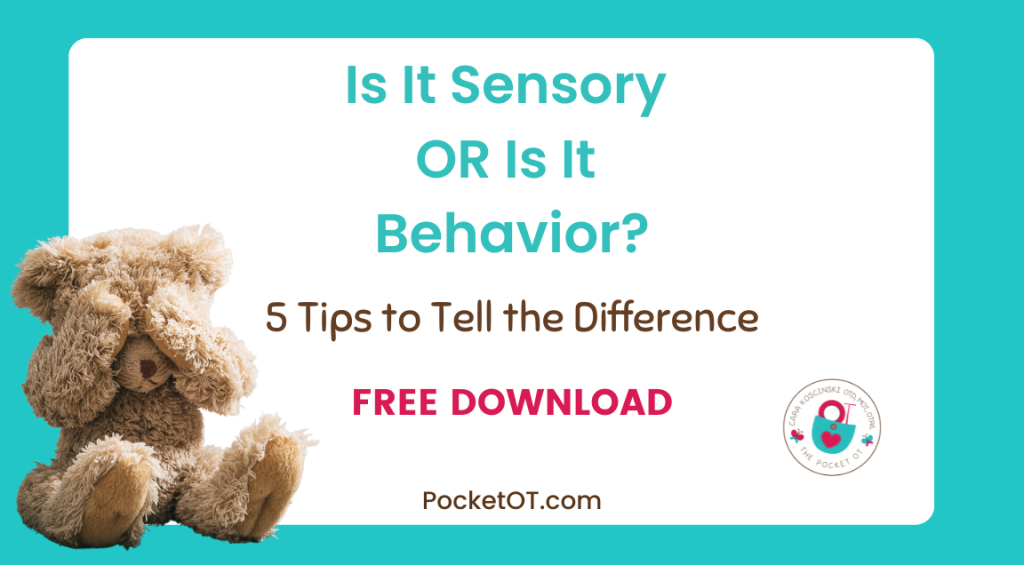
20 Snowman Crafts
Who wants to build a snowman? We do! This week we’ve rounded up some snowman crafts and activities. Each link contains a fun…

Identifying whether it is sensory or behavior is much more complicated than you might think. A few years ago, we were trying to determine how to tell the difference between sensory and behavior and now, we understand that ALL behavior is communication. It’s our job to determine what a child is trying to communicate to us. We offer an AOTA-approved course for 6.5 hours of professional development that is packed with research and various interventions.
The key is to look for patterns in daily routines and try to intervene BEFORE the child experiences the meltdown. When any child or adult reaches the ‘point of no return’ an actual chemical reaction occurs in the brain! That’s right when our brain stem releases stress chemicals, there’s no ‘off’ switch. We simply need to go to a safe place to calm down until those hormones are re-absorbed by our bodies. We are designed for self-protection and if we interpret a sensory stimulation as dangerous or painful, we go into protection mode — over which we have little physical control!
When the body is taking time to re-absorb the chemicals, the focus at that time is SAFETY!
1. Take time to investigate or review what sensory processing disorder is. Remember that there are now EIGHT senses……interoception is so critical to our own regulation. We feel emotion, pain, urges, impulses, internal organs and so much more. Interoception is what makes you, you. We are continually learning about interoception and Cara’s book on interoception is continually selling out!
Each person’s brain can actually process and understand sensations in different ways. It’s so very subjective.
2. Consider that posture and motor planning are actually a part of sensory processing. I think most OTs understand this but need reminders that even sitting upright in a chair or planning body movements can be extremely difficult and require a great deal of energy (see my earlier post about dyspraxia). We all know students or children who constantly move and wiggle in the chair OR wrap their legs around the chair legs just to gain a stable position to complete written work. This can cause a great deal of fatigue in our kids.
3. Know that a child may be ‘holding it together’ at school and then NEED to melt down as soon as they are with their parents. I often hear about kids who show their worst behavior in front of their caregivers. That’s actually a GOOD thing…..consider yourself a person who is comforting to your child if this happens. We know that kids do well when they can…..so when they’re exhausted, they let it all go. Give a safe area for meltdowns.
Print out our free list of Calming Sensory Boxes and Break Ideas/Areas for your Child HERE.
4. Offer breaks when you see signs of a meltdown…….this is called proactive response. The trick with behavior is to catch it before the meltdown or breakdown occurs. Know the signs of a meltdown. They include a red face, social withdrawal, increases in self-stimulatory behaviors, sweating, increased rigidity, and so many more. Make a list of your child’s signs of a meltdown and share it with the team. This can be done at any age. Prevention is so important. There should be many different options from which your child can choose. Some are more effective at different times and situations. Practice, practice, practice before a meltdown actually occurs so you and your child are familiar with the plan. The plan is ALWAYS to keep the child safe during a meltdown.
5. When a child is showing a behavior to obtain what they want, they will usually avoid self-injury. Consider your own behavior. When you want something and do not get it, how do you react? You are reacting in a way that’s not dangerous to yourself but are attempting to get attention or find someone to give you something you desire. When a child is in a sensory meltdown, he/she does not consider safety since it’s a chemically driven reaction. She can also stop the tantrum after her needs are met. This is an important thing to note when trying to determine the ‘why’ behind a behavior.
Want more information? Take our AOTA-approved course. It’s research-based and effective for giving strategies you can use immediately to become aware of behaviors and sensory meltdowns. There are interventions to use after completion of the course. If you’re a parent, we will offer a discount for you to watch. Contact us.
TEACHERS and paraprofessionals, we welcome you to take the course too!



